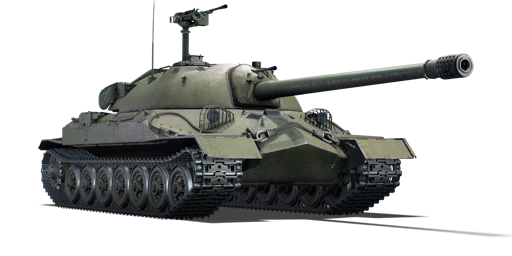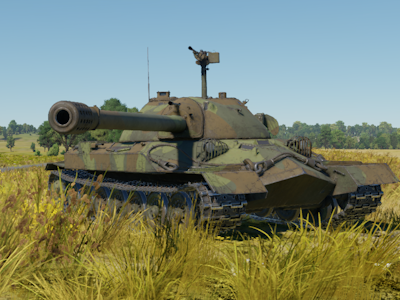The IS-7 is the sixth variant of the IS heavy tank family. It is a Soviet heavy tank that began development in 1945 under the project designation Object 260. The vehicle only existed as a prototype before being cancelled in favour of the T-10 (IS-8) variant. Nikolai Fedorovich Shashmurin designed the IS-7 in Leningrad in 1945. It was the largest and heaviest member of the IS heavy tank family, weighing 68 tonnes and armed with a long-barreled 130 mm S-70 tank gun. It was also one of the most sophisticated heavy tank designs. The armour was designed in the same way as the IS-3, with a pike nose on the upper glacis wearing 150 mm of armour inclined at a 65° angle. The lower glacis was supposed to be 100 mm thick, however, measurements revealed that it may be as thick as 110-120 mm depending on welding variances. When shot from the front, the sharp angle of the pike nose increases the possibility of a ricochet. The 130 mm S-70 tank gun was a naval gun adaptation that fired a 33 kilogram armour-piercing round with a muzzle velocity of 900 metres per second. The gun's loading mechanism used an assisted loading mechanism with a conveyor belt system. It could hold six ready rounds before needing to be replenished. The rounds were divided into two parts: the shell and the propellant. According to Nicholas Moran, the prototype IS-7 had eight machine guns and might have had to remove five of them if it had gone into production. The IS-7 was an outstanding breakthrough vehicle, but it was far too heavy and expensive to build; the T-10 was better suited for warfare as it was much easier and cheaper to transport. Work on the IS-7 was terminated on February 18, 1949.
Introduced in Update 1.79 "Project X" as the main reward of the 2018 Operation S.U.M.M.E.R. event, the IS-7 is one of the greatest heavy tanks available to the Soviet Army ground forces. It's best to play it in the medium range. The IS-7 has substantially fewer concerns with flankers than prior IS heavy tank variants since its side armour is significantly thicker. Almost no conventional round can penetrate the frontal armour, and there are few weak spots. The IS-7 has an assisted loading mechanism with a conveyor belt system that allows for the loading of 130 mm rounds in as little as 10 seconds. In addition to its impressive armour, the IS-7 is armed with no less than eight machine guns, which serve as an effective deterrence to any light vehicles that may wander into its path. Furthermore, the IS-7 is equipped with a substantially more powerful engine than previous IS heavy tank variants, improving acceleration and manoeuvrability without sacrificing any maximum forward or reverse speed. IS-7 players should not be discouraged by challenging terrain, as the broad tracks and powerful engine will make swift work of any surface. The IS-7 should be used as a breakthrough tank, pushing forward to allow friendlies to use lighter vehicles to secure objectives. However, be aware that it is not completely invincible, as experienced opponents may exploit the vehicle's few minor flaws. Furthermore, some high-calibre rounds (such as the FV4005 and Conway) will easily disable your vehicle regardless of where they hit.














